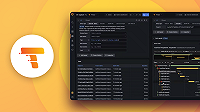Service graphs
A service graph is a visual representation of the interrelationships between various services. Service graphs help you to understand the structure of a distributed system, and the connections and dependencies between its components:
- Infer the topology of a distributed system. As distributed systems grow, they become more complex. Service graphs help you to understand the structure of the system.
- Provide a high-level overview of the health of your system. Service graphs display error rates, latencies, as well as other relevant data.
- Provide an historic view of a system’s topology. Distributed systems change very frequently, and service graphs offer a way of seeing how these systems have evolved over time.

How they work
The metrics-generator processes traces and generates service graphs in the form of Prometheus metrics.
Service graphs work by inspecting traces and looking for spans with parent-children relationship that represent a request. The processor uses the OpenTelemetry semantic conventions to detect a myriad of requests. It supports the following requests:
- A direct request between two services where the outgoing and the incoming span must have
span.kind,client, andserver, respectively. - A request across a messaging system where the outgoing and the incoming span must have
span.kind,producer, andconsumerrespectively. - A database request; in this case the processor looks for spans containing attributes
span.kind=clientas well as one ofdb.nameordb.system. See below for how the name of the node is determined for a database request.
Every span that can be paired up to form a request is kept in an in-memory store, until its corresponding pair span is received or the maximum waiting time has passed. When either of these conditions are reached, the request is recorded and removed from the local store.
Each emitted metrics series have the client and server label corresponding with the service doing the request and the service receiving the request.
traces_service_graph_request_total{client="app", server="db", connection_type="database"} 20Virtual nodes
Virtual nodes are nodes that form part of the lifecycle of a trace, but spans for them aren’t collected because they’re outside the user’s reach or aren’t instrumented. For example, you might not collect spans for an external service for payment processing that’s outside user interaction.
Virtual nodes can be detected in two different ways:
- The root span has
span.kindset toserver. This indicates that the request has initiated by an external system that’s not instrumented, like a frontend application or an engineer viacurl. - A
clientspan doesn’t have its matchingserverspan, but has a peer attribute present. In this case, assume that a call was made to an external service, for which Tempo won’t receive spans.- The default peer attributes are
peer.service,db.nameanddb.system. - The order of the attributes is important, as the first one is used as the virtual node name.
- The default peer attributes are
A database node is identified by the span having at least db.name or db.system attribute.
The name of a database node is determined using the following span attributes in order of precedence: peer.service, server.address, network.peer.address:network.peer.port, db.name.
Metrics
The following metrics are exported:
Duration is measured both from the client and the server sides.
Possible values for connection_type: unset, virtual_node, messaging_system, or database.
Additional labels can be included using the dimensions configuration option, or the enable_virtual_node_label option.
Since the service graph processor has to process both sides of an edge, it needs to process all spans of a trace to function properly. If spans of a trace are spread out over multiple instances, spans aren’t paired up reliably.
Activate enable_virtual_node_label
Activating this feature adds the following label and corresponding values:



